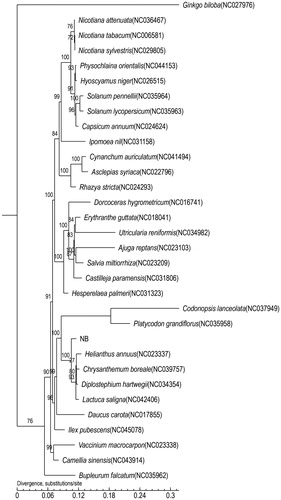Abstract
Complete mitogenome sequence of an important medicinal plant, Arctium lappa, was determined for the first time. The entire circular genome is 312,598 bp in length (GenBank accession number SRX7565441), with 45.43% GC contents. The genome has 131genes, including 33 known protein-coding genes (PCGs), 25 transfer RNAs (tRNAs), and 6 ribosomal RNAs (rRNAs). The phylogenetic trees are built based on 32 plants, using the maximum-likelihood method. The data will provide certain help to subsequent botany for classifying plants
Asteraceae, a family of dicotyledons, has about 1000 genera and 25,000–30,000 species, widely spread all over the world. Arctium lappa, known as burdock, Niu Bang (NB) in Chinese, is a biennial herb of Asteraceae has been used for treatment in Europe, North America and Asia for hundreds of years (Chan et al. Citation2011). Burdock not only has a long medicinal history, but also has a history of consumption. Burdock leaves and stems are used as snacks (Tardio et al. Citation2005). There are about 11 species of Arctium (Asteraceae) in the world, widely distributed in temperate regions of Eurasia. Recent studies of Arctium from China have focused on medicinal quality, DNA barcode sequence identification, chemical composition, and pharmacological effects (Xu et al. Citation2011). Burdock main effects include dispelling wind-heat, clearing the lungs, draining skin eruptions, detoxifying, and relieving a sore throat, which is described in the Chinese Pharmacopeia (National Pharmacopoeia Commission Citation2015; Kang et al. Citation2019). And, we have completed the chloroplast sequencing of A. lappa (Xing et al. Citation2019).
To better understand the phylogeny of Arctium, we sequenced, assembled, and annotated the complete mitogenome of A. lappa. Fresh leaves of A. lappa were collected from Dalian, China (E 121°52′38.06″, N 39°03′46.59″). Plant samples and genomic DNA were deposited in the herbarium of Liaoning University of Traditional Chinese Medicine. Accordingly, it is feasible that mitogenome information of the Arctium species will lead us a further understanding of the evolutionary history.
The complete mitochondrial genome of A. lappa, an important medicinal plant, was sequenced for the first time. The entire circular genome was 312,598 bp in length (GenBank accession number SRX7565441), with 45.43% GC contents. The genome harbored 131 genes, including 33 known protein-coding genes, 25 tRNA genes, and 6 rRNA genes. Total length of coding genes was 81,252 bp, 25.99% of the total genome length. The average length of tRNA was 76 bp, while the rRNA was 1750 bp, respectively. Additionally, we found 9 genes (nad1, nad2, nad4, nad5, nad7, cox2, rps3, rps14, ccmFc) containing 21 introns.
The evolution rate of mitochondrial genome is different among different taxa (family, genus, species), and the evaluation of its systematic meaning and its species identification significance should be analyzed according to the specific situation (). Phylogenetic analysis was performed based on the complete mitochondrial genome of 32 species, including 31 Asterids plants (including Arctium lappa, NB), 1 species (Ginkgo biloba) of the outgroup. All the species accession numbers used in this study are listed. The obtained maximum-likelihood tree showed that Arctium lappa can be grouped into a single branch, which is separated from the other four Asterids plants and as the outgroup species, Ginkgo biloba is far from the other chosen species. The result is reliable and such data will provide certain help to subsequent botany for classifying plants.
Disclosure statement
No potential conflict of interest was reported by the author(s).
Additional information
Funding
References
- Chan YS, Cheng LN, Wu JH, Chan E, Kwan YW, Lee SMY, Leung GPH, Yu PHF, Chan SW. 2011. A review of the pharmacological effects of Arctium lappa (burdock). Inflammopharmacology. 19(5):245–254.
- Kang TG, Dou DQ, Xu L. 2019. Establishment of a Quality Marker (Q-marker) system for Chinese herbal medicines using Burdock as an example. Phytomedicine. 54:339–346.
- National Pharmacopoeia Commission. 2015. People’s Republic of China pharmacopoeia A. Beijing: China Medical Science and Technology Press.
- Tardio J, Pascual H, Morales R. 2005. Wild food plants traditionally used in the province of Madrid. Econ Bot. 59:122–136.
- Xing YP, Xu L, Chen SY, Liang YM, Wang JH, Liu CS, Liu T. 2019. Comparative analysis of complete chloroplast genomes sequences of Arctium lappa and A. tomentosum. Biol Plantarum. 63:565–574.
- Xu L, Dou DQ, Wan B, Yang YY, Kang TG, Liu Y. 2011. Identification of traditional Medicine Fructus Arctii by nuclear ribosomal DNA ITS sequences. China J Chin Mater Med. 36:338–341.

